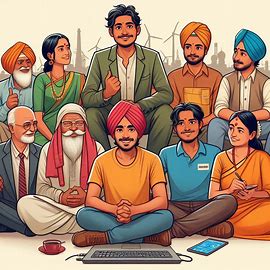Unemployment Problems in India
“Unemployment Problems in India.” India has faced various challenges related to unemployment. However, it’s essential to note that the situation may have evolved since then. Unemployment, a pressing issue in India, refers to the situation. Where a significant portion of the labor force is unable to find gainful employment despite actively seeking it. This multifaceted problem has deep-rooted causes and far-reaching consequences for the nation’s economy and society.
Here are some key aspects of the unemployment problems in India up to that point:
- Population Growth: India has a large and growing population. Which adds to the challenge of generating enough jobs to meet the demand. The sheer number of people entering the job market each year can strain the employment infrastructure.
- Skill Mismatch: There is often a gap between the skills possessed by the workforce and the skills demanded by industries. This results in structural unemployment, where available jobs do not align with the qualifications and expertise of the workforce.
- Informal Sector Dominance: A significant portion of the Indian workforce is employed in the informal sector. Which lacks job security, benefits, and legal protection. This makes workers vulnerable to economic fluctuations and leaves them without a safety net.
- Educational Disparities: Disparities in educational opportunities contribute to unemployment issues. Some regions may lack access to quality education, leading to a workforce with inadequate skills for the job market.
- Industrial Slowdowns: Periods of economic slowdown and industrial stagnation can result in reduced job creation. Factors such as global economic trends, policy changes,. natural disasters can impact the growth of industries and subsequently affect employment.
More Here…
- Agricultural Challenges: A significant portion of the population is engaged in agriculture. Which often faces challenges such as weather fluctuations, low productivity, and a lack of modernization. This can contribute to underemployment and unemployment in rural areas.
- Government Policies: Sometimes, policy inefficiencies or inconsistencies can hinder job creation. Simplifying regulations and creating a more business-friendly environment can encourage entrepreneurship and boost employment.
- Technological Disruption: Automation and technological advancements can lead to job displacement in certain sectors, especially in traditional industries. While technology can create new jobs, there may be a transitional period during which workers face unemployment.
- Mismatch of Aspirations and Opportunities: There might be a disparity between the aspirations of the youth and the available job opportunities. This can lead to frustration and dissatisfaction among educated youth.

Causes of unemployment in India:
- Rapid Population Growth: India’s burgeoning population has outpaced job creation, leading to an ever-increasing number of job seekers.
- Skill Mismatch: The mismatch between the skills possessed by the labor force and the demands of the job market contributes to unemployment.
- Structural Changes: The shift from agriculture to industries and services has led to job losses in traditional sectors without adequate opportunities in emerging sectors.
- Lack of Quality Education: Inadequate access to quality education and vocational training limits the employability of a large segment of the population.
- Rigid Labor Laws: Inflexible labor laws make it challenging for businesses to hire and retain workers, discouraging investment and job creation.
Consequences of Unemployment in India:
- Economic Impact: Unemployment leads to reduced consumer spending, decreased tax revenue, and slower economic growth.
- Social Impact: Joblessness can result in poverty, social unrest, and increased crime rates. It also affects mental well-being and social inclusion.
- Brain Drain: Talented individuals may seek opportunities abroad due to limited job prospects in India, leading to a loss of skilled professionals.
Final Words
Addressing unemployment in India requires a multifaceted approach that involves educational reforms. Skill development programs, promoting entrepreneurship, and creating an environment conducive to economic growth. It’s important to note that the government and private sector. Civil society plays a crucial role in finding sustainable solutions to these challenges.
Unemployment requires comprehensive policies that focus on skill development, job creation, and improving the overall business environment. By tackling the root causes and implementing effective strategies, India can strive towards reducing unemployment and fostering inclusive economic growth
